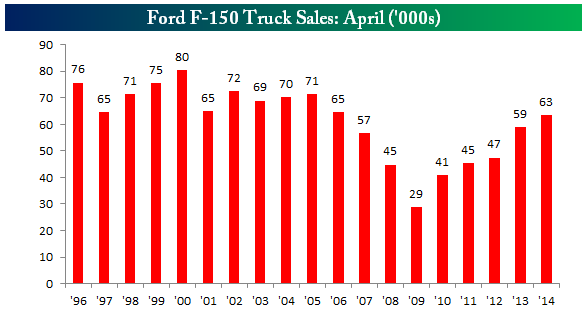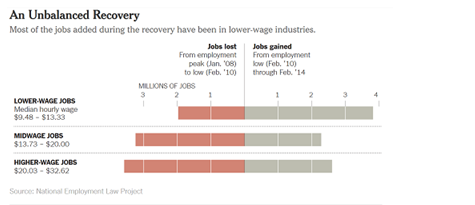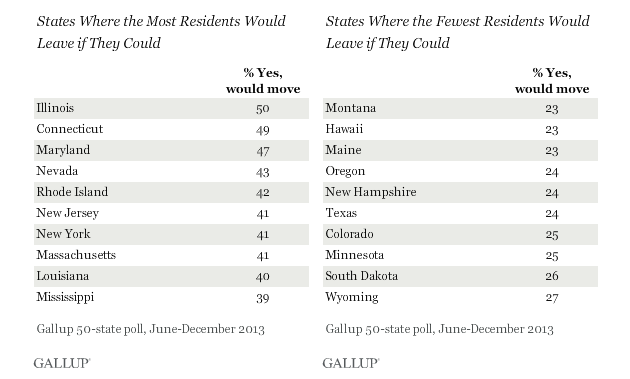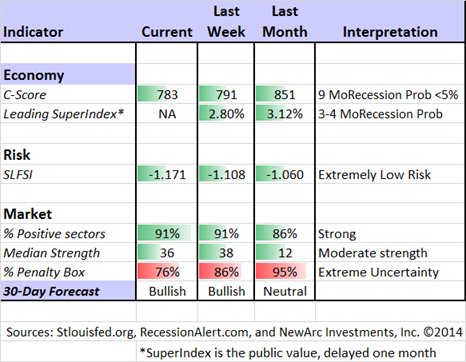How worried should we be about the Ukraine crisis?
Last week some regular readers whom I respect asked why I did not mention the Ukraine situation. It was a fair question, given the attention from the financial media. My answer was that it was an important story on many fronts – defining the future Putin role, setting precedents for NATO and the us, and of course, the people directly suffering in the conflict. I did not view it as a "market crisis" despite the 50 basis point moves that are often attributed to Ukraine news.
Since it is a light week for data, the field is open for more pundit pontification, perhaps including a few who can actually find Crimea on a map and know a few facts.
Prior Theme Recap
Last week I expected a repeating chorus of "sell in May" no matter what happened on the economic front. That was a good guess. We were bombarded with articles on that theme and most cited that type of data that I warned about last week. The actual data were quietly positive, and so was the market.
Forecasting the theme is an exercise in planning and being prepared. Readers are invited to play along with the "theme forecast." I spend a lot of time on it each week. It helps to prepare your game plan for the week ahead, and it is not as easy as you might think.
Naturally we would all like to know the direction of the market in advance. Good luck with that! Second best is planning what to look for and how to react.
This Week's Theme
Is the Ukraine situation a market crisis?
Saying "Yes" are those who take one of the following positions:
- There is a chance of armed conflict between Russia and the US or NATO;
- Sanctions against Russia will cripple the entire European economy, upsetting the oil trade relationship;
- Increased energy prices will derail the European economy with a possible ripple effect.
Saying "No" are those who focus on quantitative impacts:
- There is no indication of direct conflict, only an escalation of sanctions;
- Global trade is supposed to bring the world closer together. This is a test;
- Increased energy prices may not enrich the leading Russians.
This might be a compelling story in a week that is light on data. There will be some early spin on the Buffett weekend, and also some earnings news. Will the market decide to take the Ukraine issue seriously?
As usual, I have some thoughts that I will share in the conclusion. First, let us do our regular update of the last week's news and data. Readers, especially those new to this series, will benefit from reading the background information.
Last Week's Data
Each week I break down events into good and bad. Often there is "ugly" and on rare occasions something really good. My working definition of "good" has two components:
- The news is market-friendly. Our personal policy preferences are not relevant for this test. And especially -- no politics.
- It is better than expectations.
The Good
There was plenty of economic news, and on balance it was pretty good.
- Earnings – both reported and expected – are solid. Brian Gilmartin has an excellent analysis of the current earnings season and the implications. Higher expectations are in place. What multiple will the market accord?
- Case-Shiller home prices were up almost 13% year-over-year. This was the expected increase, but "good news" because of question marks on other recent home sales data.
- Auto sales were encouraging, especially the Ford F-150 truck, which tracks small business and construction. This is a good one for those conspiracy buffs who are suspicious of the "official" numbers. (Via Bespoke).

- Employment growth surprised to the upside. The trend is a little better than the sluggish GDP data suggest. The WSJ has a balanced summary, with an appropriate upside tilt.
- ISM manufacturing registered 54.9, a solid increase consistent with 3.9% annualized economic growth. Steven Hansen has a more skeptical take at GEI.
The Bad
There was also some bad news.
- GDP growth in Q1 was anemic. It is certainly bad news as the base for future growth. The market seems to be granting a "weather exception." We shall see. Some sources see the quarter in negative territory. (Merrill Lynch via Calculated Risk).
- Initial jobless claims rose again, to 344K. Job losses are only half of the story when it comes to net job creation, but this data series has been a good indicator.
- Employment growth is concentrated in the low-wage jobs. The NY Times has good coverage.

The Ugly
Dissatisfaction with where you live. I confess that I was astounded by the recent Gallup survey asking people if they would prefer to live in a different state. Before looking at the result, what do you suppose would be the high and the low? Do you think that many people want to move, or are generally satisfied?
It turns out that even in Hawaii (and Montana) 23% of the residents would rather live elsewhere. That is the best. I am surprised.
On the negative side, half of the residents of my state (Illinois) would rather move on. This would be a good question for "Family Feud." How many of the best and worst states could you name? I think the big story is that so many would like to move. This probably has implications for employment, inability to sell homes, and other issues. Here are the tables of the worst states and the best:

Runner-up this week: Prop traders' failure rate. The TV ads make it seem so easy……
Quant Corner
Whether a trader or an investor, you need to understand risk. I monitor many quantitative reports and highlight the best methods in this weekly update. For more information on each source, check here.
Recent Expert Commentary on Recession Odds and Market Trends
Georg Vrba: Updates his unemployment rate recession indicator, confirming that there is no recession signal. Georg's BCI index also shows no recession in sight. For those interested in Canadian stocks, Georg has unveiled a new system.
Bob Dieli does a monthly update (subscription required) after the employment report and also a monthly overview analysis. He follows many concurrent indicators to supplement our featured "C Score." One of his conclusions is whether a month is "recession eligible." His analysis shows that none of the next nine months could qualify. I respect this because Bob (whose career has been with banks and private clients) has been far more accurate than the high-profile punditry.
Doug Short: An update of the regular ECRI analysis with a good history, commentary, detailed analysis and charts. If you are still listening to the ECRI (2 ½ years after their recession call), you should be reading this carefully. He notes that the ECRI has emerged from hibernation. "Interestingly, the interview includes no reference to ECRI's recession call, instead focusing on whether the winter economic downturn was weather-related or reflective of a cyclical downturn."
If you had to pick a single indicator for concurrent economic strength, a summary of what the NBER looks at when determining the start and end of recessions, you would follow Doug Short's regular Big Four summary.

The Week Ahead
We have a light week for news and data.
The "A List" includes the following:
- Initial jobless claims (Th). Best concurrent read on employment.
- ISM services (M). Not as widely followed as the manufacturing index, but still significant.
The "B List" includes:
- Trade balance (T). Key GDP component.
- JOLTS report (F). Job openings rate is interesting but the quit rate is most important.
With the FOMC meeting over, we can expect the resumption of FedSpeak. I do not expect anything significant.
We have continuing earnings news, as well as more from Ukraine.
How to Use the Weekly Data Updates
In the WTWA series I try to share what I am thinking as I prepare for the coming week. I write each post as if I were speaking directly to one of my clients. Each client is different, so I have five different programs ranging from very conservative bond ladders to very aggressive trading programs. It is not a "one size fits all" approach.
To get the maximum benefit from my updates you need to have a self-assessment of your objectives. Are you most interested in preserving wealth? Or like most of us, do you still need to create wealth? How much risk is right for your temperament and circumstances?
My weekly insights often suggest a different course of action depending upon your objectives and time frames. They also accurately describe what I am doing in the programs I manage.
Insight for Traders
Felix has continued the bullish rating, but it is still a close call. We have been mostly out of US equities, but fully invested for trading accounts. Somewhat to my surprise, we never got a "buy" signal on the inverse ETFs. The Dow and the S&P 500 look better and the QQQ's have also rebounded to the neutral range. Many more sectors have earned good ratings, but are still in the penalty box, reflecting higher uncertainty.
Those who want to follow Felix more closely can check us out at Scutify, where he makes a daily appearance to join in vigorous discussions about trading.
Insight for Investors
I review the themes here each week and refresh when needed. For investors, as we would expect, the key ideas may stay on the list longer than the updates for traders. The current "actionable investment advice" is summarized here.
Because we have been trimming winners in our "long stock" program, we have prepared to buy on dips. I have added some to these positions yet, and we are shopping. I am especially interested in regional banks, energy and some "old tech."
Those following our Enhanced Yield approach should have enjoyed yet another good week in a sideways market. It is important and helpful to own value stocks that pay dividends and add some hedging via short calls. I have written several times about examples that you can try on your own. It reduces your risk. Start small and get the sense of how to do it.
Here are some key themes and the best investment posts we saw last week.
Be a good consumer of investment information. Regular readers know that I applaud the advice from Barry Ritholtz, suggesting that you take the role of skeptical litigator. Ask about the motives and biases of the source. Barry writes:
If you consume lots of stock research or market commentary — or much of anything from the financial media — then you will find this exercise especially important. Let's look at the motivations of various pundits, strategists and fund managers. Suit up in your finest barrister gear; we are going to play "cross-examining litigator" for fun and profit.
You should read the entire list of characters, but I will take the liberty of quoting two entries – enough to whet your appetite. The combination is powerful, and an explanation of how so many have been so wrong for so long.
The end-of-the-worlders: Since the rally began in 2009, we have seen the usual crowd of Web sites, newsletter writers and pundits forecasting a terrible crisis that you simply must note: The Fed has run amok. We are running out of food. Fiat currency is soon to be worthless.
They seek to take advantage of your tendency to succumb to the recency effect, where you place excess value on what just happened. After the financial crisis, your natural tendency is to look for another one, and they have just the newsletter to help you with that. Let me remind you that the end of the world bet has yet to pay off, and when it finally does, whom are you going to collect from?
Gold bugs have a narrative, which they pursue regardless of new data. My favorite oft-forgotten factoid is that the SPDR Gold Shares ETF (ARCA:GLD) was the brainchild of the World Gold Council. WGC was created by global mining companies for the sole purpose of promoting the sale of gold. The GLD ETF came about after "two decades of depressed prices and a growing glut of the yellow metal." As we discussed here, GLD was a bit of a Hail Mary to find a way to deal with price and inventory pressures. (Mission accomplished).
Imagine a Venn diagram showing a cross-section of gold bugs and doomers, and you end up with the "physical gold" crowd. They insist: "The whole system is going to collapse, you cannot even own the ETF — you must own physical gold!" And they are happy to sell some to you.
Don't mix politics with your investing! (Where have we heard that before?) A big fund manager has this warning for his wealthy investors:
The founder of Greenspring — which manages nearly $1.8 billion from Towson, Md. — says basing investment decisions on emotional views about Obamacare, unemployment or the deficit instead of more relevant information can seriously threaten a client's financial plan. "The worst short-term risk is missed opportunity," says Collins. And in the long term, "going to cash will make it so that you can't sustain your lifestyle as you should."
Bullish Charts. The charts showing a gloomy ten-year forecast get a lot of press. Here is an alternative view from Ryan Detrick – you need to read the entire post to understand the analysis. He concludes, "…bigger picture this says there is still a lot of room to move higher over the coming years."
If you are obsessed about possible market declines, you have plenty of company. This is one of the problems where we can help. It is possible to get reasonable returns while controlling risk. Check out our recent recommendations in our new investor resource page -- a starting point for the long-term investor. (Comments and suggestions welcome. I am trying to be helpful and I love and use feedback).
Final Thought
Let us suppose that you are a trader. You are trained to look for the market implications from any news. Suppose that there is some escalation of tension in the Ukraine. It cannot possibly be good news, so the general reaction is to sell. Depending upon where the market is in the daily trading range, a little selling can beget more selling. It really does not mean much.
If you are a long-term investor, shopping for new positions, you can use volatility to your advantage.
If you are a trader, these news events are not very helpful. The news from the Ukraine is unpredictable in nature, size, and market effect. Traders are reacting without much evidence.
That is why the market moves – despite the media hype – are rather small. The quest to explain every 50 basis point move in the markets is Quixotic.


